On the Saturday before Earth Day, West Hartford held their celebration of it in Blue Back Square. They had Hila the Earth rapping about compost and carrots, lots of free wildflower seeds, information about pollinators, and made this happen by converting a redundant street to people-only space for the occasion.
While this great all-ages event provided opportunity to take a pledge to shut off unnecessary outdoor lights during peak migration to make Connecticut safer for birds, it really highlighted the Town of West Hartford’s cognitive dissonance, coming right after decision-makers announced that they actually don’t care for protecting human lives.
What happened has been pretty well documented, so here’s the short version: public demand basically forced the Town of West Hartford to act as if it cared at all about pedestrian and cyclist safety, there were the predictable theatrics that come from creating committees/task forces and all that, and then instead of reaching for innovation, the decision-makers ever-so-predictably shrank because a few complainers complained about losing parking. I know that what happened felt very specific and fresh for those in town who maybe have not lived elsewhere or been involved in such things before, but from the outside, it was absolute playbook. It’s the kind of experience that leaves residents feeling disenchanted by democracy, and sour at what seems like manipulation.
For those who don’t know the area, West Hartford is the poster child for upper middle class respectability politics. It’s the kind of place where people will be scorned for “incivility” but not for doing something truly heinous. Advocates have been told, even, that their tone was responsible for why a bike lane project elsewhere in town was scrapped, which of course creates hesitation in some now; the truth is that if being civil and asking politely mattered that much, West Hartford would have been a leadership in walk- and bikeability years ago.
In a place where so-called civility ranks higher than true care, you can tell choices are made with the expectation that those upset by a decision won’t rock the boat or do anything too vocal, lest they break that code and become outcasts.
But, there is potential for things to be different this time: advocates for a higher quality of living in West Hartford have gotten more empowered in the last few years and may not simply walk away grumbling.
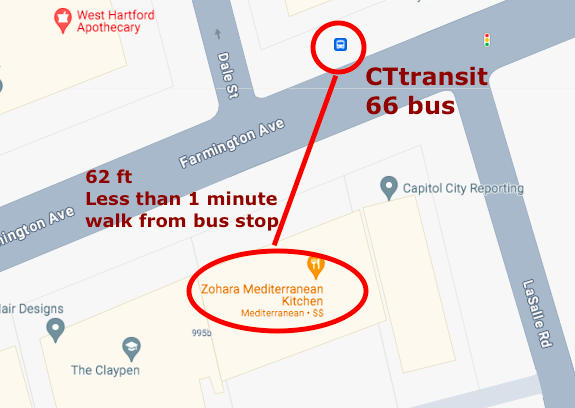
Before showing some of how West Hartford residents are challenging this bad call, I want to spend time on something that is glaringly obvious to me: the Town of West Hartford, along with many of the retail and restaurant owners, do not even take into consideration those who ride buses.
Almost every time I leave Hartford, I am doing so by bus. This is how I get to West Hartford; it’s town center is one of the areas in Greater Hartford served best by public transit. This does not mean it’s great once I exit the bus, or that delivery drivers aren’t constantly blocking the bus stop in front of Chase on Farmington Avenue. All it means is that if I want to go to or from West Hartford Center (including Blue Back Square), there are buses running every single day between there and downtown Hartford, and then on most days beyond the Center to West Farms, Tunxis Community College, and more. Every day, the zigzagging CTfastrak 153 bus goes through the Center to Copaco, the JCC, and Elmwood. For the CTtransit buses that go between downtown and the Center, they run so often Monday-Saturday that I don’t bother to look at a schedule to see when the next bus is coming.
You would not know any of this from WeHa’s suburban nonsense.
Instead, the whole conversation has been a false dichotomy of “we can have bike lanes or we can have parking spaces,” and nowhere in there does the Town of West Hartford advise anyone that they could take a less dumb mode of transportation and avoid the parking non-situation altogether: ride the damn bus! Even at the recent Earth Day event at Blue Back Square, there was hardly any acknowledgment the role that car and truck emissions play in trashing our habitat. I’m guessing that would bring too much realness, asking people to confront one of the largest ways they have had a hand in metaphorically shitting where they eat.
Why decision-makers aren’t actively working to reduce the number of cars coming into West Hartford Center is beyond my understanding. This whole time, they could have been campaigning for town residents and local area visitors to make smarter choices: carpool, use public transportation, bike, walk. Reducing the number of vehicles being driven is the way to reduce congestion and free up more of the already ample number of parking spaces in the Center. It’s not as if they would even need to set bold goals like shifting 20% of drivers to other modes: the amount of parking that the Center plan could have cut was less than 1%. If the Town got 5% of visitors/workers in the Center to change mode, the few parking spaces removed would not have been even the slightest bit noticeable to motorists. If for no other reason, that should have been enough. They want to receive silver-level Bicycle Friendly Community status without having earned it.
But, there are other reasons, and some of them are such that we have to ask why restaurants/bars that serve alcohol are not behaving as if they care about having their customers stay safe (and keep others safe). This is not a specific-to-West Hartford issue, yet it is an issue that alcohol-serving establishments in Connecticut are generally blasé about the effects of the product they serve, and all too often, over-serve.
There are many layers of failure happening, and at any point, all of those involved could do better if they wanted to.
To start, the Town of West Hartford and all of the businesses in the Center/Blue Back could take a step by acknowledging how taking public transit — not to mention cycling and carpooling — means that visitors do not need to look or pay for parking.
Although not every bus runs on Sundays and some do not run very late, and not every person is going to be served by a bus, it’s also worth remembering that not every person drives, not every person drives at night, not every person exists without a curfew, etc., and unfortunately, all of that has to be said to remind folks that no one way works for everyone, so don’t make a big deal about how bicycles or buses don’t fulfill everything for everyone. Nothing does. Move on.
With that said, those who live a short walk/roll from any of the buses going to the Center should be encouraged to use them.
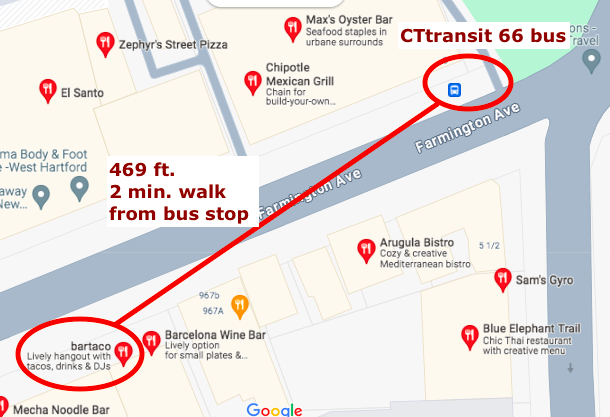
It takes less time to walk from most of the bus stops to the destination than it takes to find a spot and then decipher the parking meter. I know this from getting off a bus, walking by people who are staring blankly at the pay stations, running into a store, and then passing them by again before they have finished their task.
With help from Google, I’m showing how people can access some of the popular destinations from existing bus stops.
For instance, it takes less than two minutes to get from the 66 outbound bus stop in front of Chase to bartaco; on days when the 66 does not run, a person who can walk one or two more minutes can still reach that restaurant by simply using one of the other nearby bus stops.
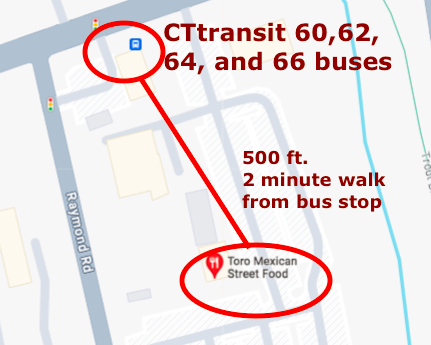
Aiming for Toro or one of the other destinations like Whole Foods on Raymond Road? Google Maps says it takes two minutes, but most of that — at least for me — is spent waiting to get the pedestrian walk signal at the corner of Farmington Avenue. There’s very little walking involved here, or to most of the places in this area.
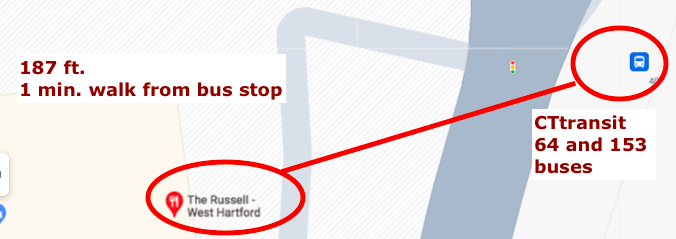
Going to The Russell or anywhere else in that plaza? It’s served by the 153 bus every day, and by the 64 bus Monday-Saturday. If coming from points north or east, there’s a bus stop on the same side of South Main Street as it, besides what is shown in the screenshot. This is the case for basically every destination — you can get there on an inbound or outbound bus.
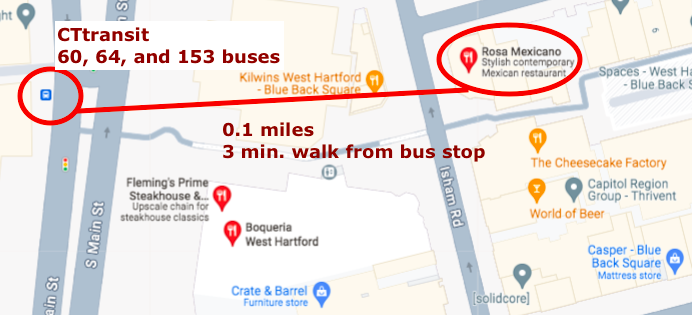
Rosa Mexicano, and other places tucked away in Blue Back Square, are a slightly longer walk in terms of distance, but a more pleasant one once in that Blue Back area where streets are quieter and seating is easier to find.
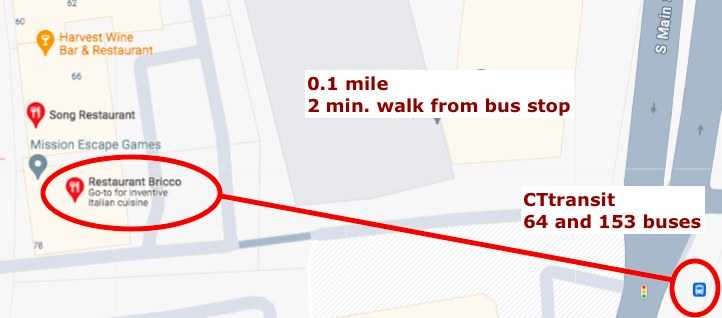
The map above shows the distance and time for those coming from South Main Street, but those traveling on Farmington Avenue can just as easily walk from one of the stops there down LaSalle Road — it adds only one minute, if that.
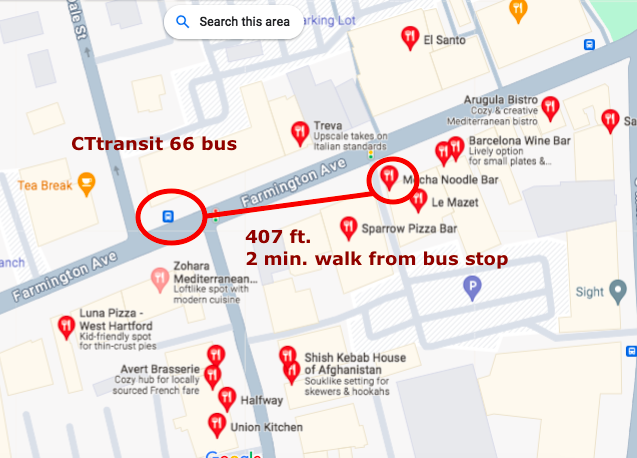
Want Mecha? It’s halfway between two of the bus stops — pick one and walk half a block one way or the other.
Want Zohara or Donut Crazy? You’re waiting for the light to change at LaSalle Road and crossing the street. That’s it. Boom, you’re there. No angst about parallel parking. No worries about when you have to refill the meter. No stress trying to back out of a space into traffic, unable to see what’s coming because someone in a land yacht parked next to you.

After looking at all the restaurants and retail in West Hartford Center/Blue Back, the longest distance I could find between storefront and bus stop was a four minute walk. Max Burger and The Place 2 Be were both described as being four minutes from the nearest bus stops — and for some people, this may be an accurate time estimate, but what I have found is that I always walk faster than what Google Maps tells me I will, and that’s not because I’m doing some kind of speedwalking.
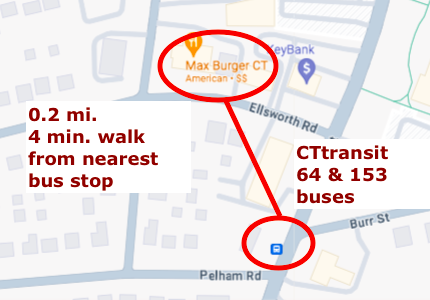
It takes very little time to figure out where one’s store/restaurant is in relation to a bus stop. My sloppy screenshots with writing on them took about one minute each. Someone with minimal skill could spend five minutes making it look nice and put this information on their business website, and then check it once a year to make sure it’s still current; bus routes rarely change. Those who aren’t so savvy can consult with CTtransit, CTrides, or if you have not actively fought against bicycle and pedestrian improvements, I’m willing to help you verify that the bus stop and schedule information is accurate — send an email.
So, that’s step one: acknowledge that West Hartford’s town center is served well by public transit and tell potential patrons and employees this.
Doing that will help the town abandon the mentality that they must at all times have enough parking to satisfy maximum demand — what they might see on Christmas Eve or Celebrate West Hartford. It will help them to think more clearly about how this space is serving us 99% of the time. I beg that they, and every last parking apologist/whiner, spend quality time looking at the satellite view in Google Maps. Get in there and really examine how the whole Center is a crater of parking, how ugly that is, and how it could be reduced by half and have no negative impacts 99% of the time.
But don’t just take my word for it. Even if I wind up in West Hartford at least once a week, I have not, do not, and will not live there. Here’s what some of the town’s own residents are saying about this major misstep taken by the Town of West Hartford:
1. The reporter responsible for writing “West Hartford’s ‘auto-centric’ plans to reconstruct its town center are a disappointment to some,” is a town resident, and in his article he points out — again — that between on-street spaces, surface lots, and garages, West Hartford’s Center/Blue Back Square has 5000+ parking spaces.
2. Tracey Wilson, town historian, reran a long article she published 12 years ago titled: “A Look Back, and Ahead, at Biking in West Hartford.” The bulk of this shares the town’s bicycle history, which goes back about 145 years. A note is added before the article, explaining that the author advocates for safe bike lanes in the town center, and that “Advocates argue that roads are for transportation for both cars and bikes. Bikers are consumers and, in fact, their vehicles take up much less parking space than do cars.”
It’s been stunning to find out how many business owners in the Center have no idea that their customers arrive by bike, on foot, or via public transportation, and even more stunning to learn that some have spoken against safety changes. Wilson, and others, are educating them about the reality that cyclists are consumers.
3. In “Parking is Destiny and We Are Blowing It,” town resident Jason Wang brings the scholarship, citing Donald Shoup and Janette Sadik-Khan — experts in the field. In this, Wang argues about not just mobility and parking, but place-making, an annoying term but beautiful concept. Of the improvements Sadik-Khan made to Broadway in NYC, he wrote: “It wasn’t rocket science. Making the public space more hospitable to humans meant humans spent more time (and money) there.” He turns it around on those who claim that maintaining excessive parking is needed to keep businesses in the Center afloat: “Do we really think the Center is special because of easy car access? If businesses prioritize car access above human access, why are they not renting much cheaper space in a strip mall?” Kudos to Wang for being confrontational. We should hear more of this from West Hartford residents, firing back at uninformed business owners and town decision-makers.
He also brings vision: “In all of the debate about where to put cars, we seem to have completely forgotten about space for our children to play. Even the area of four or five parking spaces could be enough for a delightful pocket park for children. Can you imagine? What if we had some small green pocket parks with big rocks or playscapes for kids to climb on, surrounded by shade trees and benches for the parents to enjoy a coffee and chat? Is that perhaps a better use of public space than four or five more parking spaces in a Center that has over five thousand?”
We have to keep saying that number. There are over 5000 parking spaces in West Hartford’s town center. To have all those spots used, that would mean . . . well, in a best case scenario, you would have a family/group of four (or more) arriving in each vehicle. That would be 20,000 people in the center all at the same time — 30% of West Hartford’s population. Is this an actual concern that any of us should be having? Let’s look at their big event: it’s estimated that 30,000 to 40,000 people attended Celebrate West Hartford, a two day event, last year. Even if 40,000, that’s spread over two days, and that’s not how many were there at the same time. Many people biked and took the bus to this event, but many more still could have made that choice.
Back to that space for kids: there is a Ben & Jerry’s in West Hartford Center, but not really a good space for people to eat those cones outdoors. The nearby green feels like it’s illegal to use. The corner park likewise looks like a place where nobody is supposed to be. If I wanted to eat my ice cream indoors, I’d get a cheaper pint and sit with it in my kitchen. Imagine if West Hartford eliminated most of that parking on South Main, added lots of benches, and installed signs that welcomed people to use the space? Why not add some picnic tables? When you start reducing space for cars, it becomes a place to be.
4. In another letter to the editor, West Hartford residents Sandy Fry (former planner & bicycle and pedestrian coordinator for the City of Hartford) and Rick Thibodeau express their disappointment over what happened to the town center’s infrastructure master plan. They reinforce that cyclists are already consumers, and that appropriate infrastructure like protected bike lanes would only act to benefit businesses in the center: “Town residents have said through surveys that they want safe cycling infrastructure so that they can access the retail and entertainment venues in the Center. And, as stated previously, businesses in the Center will benefit economically from increased foot and bike traffic. The town’s leaders should be bold and courageous. Future and current generations will thank them for their foresight.”
Another way to read that: Town of West Hartford’s decision-makers are currently lacking in courage and in vision.
5. Bike West Hartford lays out West Hartford’s lack of vision this way: “Are 32 street parking spaces worth risking the lives of pedestrians and cyclists? Are those 0.6% of total Center parking spots worth losing the vibrant ‘gardens of eating’ that have made West Hartford Center a unique summer dining destination? That’s the trade-off promoted by the Town of West Hartford’s April 8 “Semi-Final” Center Master Plan.”
The plan went to hell because they would lose 32 unnecessary parking spaces out of the 5000+ parking spaces currently available in West Hartford’s town center.
Bike West Hartford describes how West Hartford is essentially unplacemaking.
There was an opportunity for everyone to win, to build on the success of outdoor dining. The reversal of the center plan should have surprised no one, as this was obviously the direction the Town of West Hartford was going in, and when someone tells you who they are, believe them.
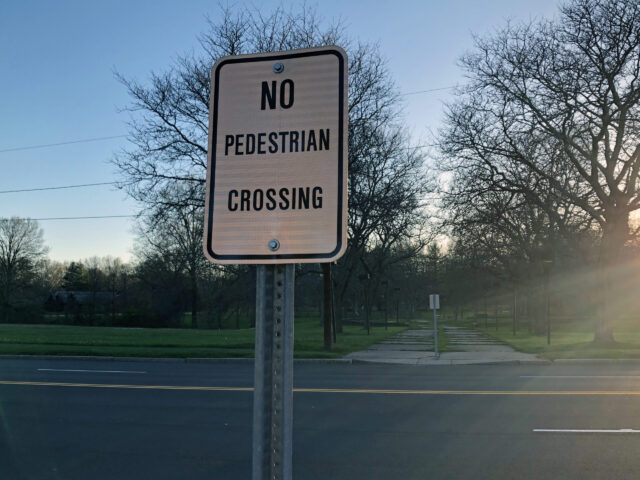
They told us who they are when they removed the pedestrian crossing on Trout Brook Drive by the Miracle League of Connecticut field.
They told us who they are when they ditched the extension of the Boulevard bike lanes.
They told us who they are when they removed the back-in only parking on LaSalle Road, and then removed the barriers, making it a two-way street again.
They told us once more when they opened thru-travel on Memorial Road Extension — a choice that has resulted in crossing times reduced for pedestrians at its intersection with South Main Street. That’s what happens when more vehicles are added and permitted to make right turns on red; drivers do this with no regard to how long pedestrians have been waiting or how little time pedestrians were granted in the first place to cross.
All of the meetings and surveys over the last year have been one giant performance.
West Hartford could have said “Yes, we will have wider sidewalks, bike lanes, full space for dining patios, and maintain a reasonable amount of parking,” but instead the Town of West Hartford cowered and traded all of that for parking spaces.
6. In “The World Is Changing, Will West Hartford Change With It?,” resident Jim Head asks questions: “In the past four years, I have heard a lot of ‘Listen to the experts’ – Why doesn’t this apply here? What is the actual logic behind the re-re-design?”
To preserve the status quo — excess amounts of parking that suck the life out of a community — lack-of-visionaries often appeal to fears held by fellow lack-of-visionaries, and in this case, they cannot envision a world in which children can go somewhere without being driven there. In part, this happens because the structures for this are largely missing from most American towns, but then they reinforce that by countering any attempt to make it so.
This letter to the editor tears that narrative, showing the author transporting his children by bike.
This is another place where we know that decision-makers in town have windshield bias; were any of them regular bike (or bus) commuters, they would be able to interrupt bogus claims by explaining that parents do take their kids places on bicycle and on the city bus.
7. I want to say “And finally…” but something tells me this won’t be the end of West Hartford’s decision-makers getting challenged on their bad decision, so . . . for now, I leave you with this post by another town resident who photographed the bikes she spotted in West Hartford on a windy and chilly day when there was no special event planned. She says it well: “People ride bikes for a variety of reasons. Some are out for a pleasure cruise, others are exercising, or commuting. All want and deserve to be safe. Just as there are requirements for crosswalks and handicap parking spaces, there should be requirements for – at the very least – bike lanes.”
This is the part where I remind everyone that when politicians say no in a political setting, you treat that as a negotiation. Town residents and those who regularly go to West Hartford may use this opportunity to send messages to town officials, letting them know that this plan of theirs is weak sauce. Be sure to copy Bike West Hartford on the emails you send to Town of West Hartford’s decision-makers.
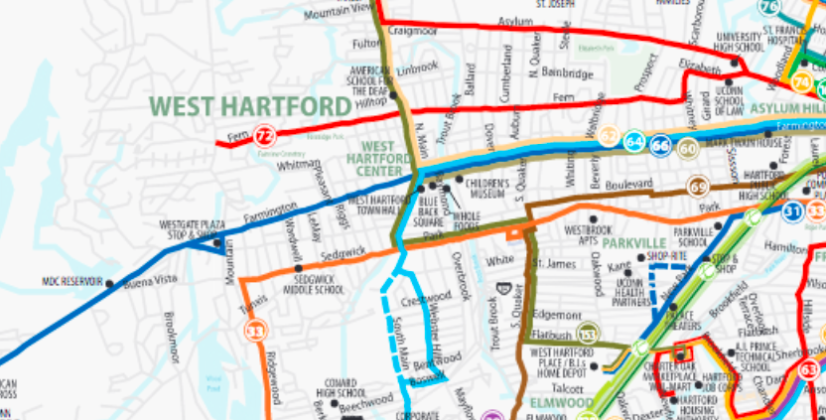
Art Spivak
Great article
Where were you when we needed a Beltway around Hartford ?